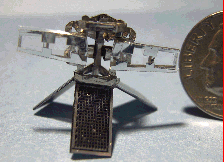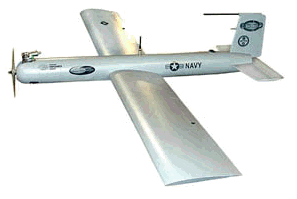|
|
Airborne Robots
|
 |
The little device at the left is a
mock-up of an ambitious project at UC Berkeley to
develop an artificial fly. If you ask me, they don't
have a chance of succeeding. The challenges are just too
great. They need to get the tiny wings flapping at 150
times per second, there needs to be some means of
keeping the system stable in the air and somehow it has
to navigate. And all this on something the size of a
dime. They have gotten one wing to flap fast enough
that, if they mount it on a little wire boom, it will
generate some thrust. In other words they are nowhere
close after years of work. This may be the type of
system that can only be developed via evolution. |
|
|
|
At right we see a little robot blimp
made with a polymer balloon. These blimps are available
as R/C controlled toys. They can be modified to add
sensors and computational hardware which can transform
them into robots. I think they are a great way to
experiment with obstacle avoidance and machine-based
decision making. You can go straight to the machine
intelligence and skip the engineering of a mobility
platform. Well, unless you think engineering the
mobility platform is the fun part. |

|
|
|
 |
I love this little robot plane
developed by the Navy. They call it the "Silver
Fox" and it really does use an engine from the
world of R/C planes. This is no R/C plane though. It is
capable of fully autonomous flight and is designed for reconnaissance, intelligence, surveillance and target acquisition
by small military units. The current model carries commercially available sensors. The goal is
to give the Silver Fox, which is also known as the Smart Warfighter Array of Reconfigurable Modules (SWARM), 24-hour
endurance a 1,500-mile range and a maximum altitude of 10,000-feet.
The idea of 100 of these things filled with explosives
flying 1000 miles and then closing on an enemy target
like a swarm of mad bees is truly terrifying. |
|
|
|
|